|
Musical Instrument Ranges and Names
::

|
Key words:
range
tuning
information |
| * |
Family Name | Instrument : Sounding Range
Concert pitch is the pitch at which non-transposing instruments sound link to : Table of sounding range and clefs used
| Instrument: Written Range
Standard open string tunings for stringed instruments
Note: string players are sometime required to mistune their strings. This is now called scordatura (e.g. Biber's Rosary Sonatas; the viola part in Mozart's Sinfonia Concertante for violin, viola and orchestra) although originally it was called accordatura (e.g. by Ariosti in his works for viola d'amore)
|
| 1 |
Bowed Strings (1) |  | Violin | more ...
sounds at written pitch | 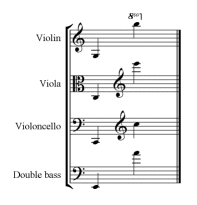 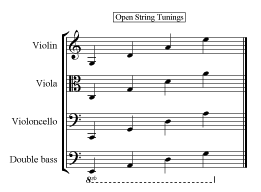 |
Violino piccolo | more...
the small violin
information about tuning |
Viola | more ...
sounds at written pitch |
Viola d'amore | more...
instrument with six bowed strings and six steel strings, the latter neither bowed nor plucked
(tuning, from eighteenth century: A, d, a, d', f#', a', d'') |
Tenor Violin | more ...
tuned an octave below the standard violin |
Violoncello piccolo | more...
a small cello with an extra e'-string above the normal strings (C, G, d & a) |
Violoncello (Cello) | more ...
sounds at written pitch |
Double Bass | more ...
sounds an octave below written pitch with four strings
sometimes fitted with a fifth string tuned to low C Note: 4-string double basses are tuned in 4ths, distinguishing them from members of the violin family with their tunings based on 5ths. For this reason, the double bass should be classified as a member of the viol family. In which case, the largest member of the violin family is the violoncello. |
Rebec | more... |
Renaissance Violin | more... |
Baroque Violin | more... |
Twentieth-century Violin Octet | more ... |
| 2 |
Bowed Strings (2) |  | Pardessus de Viol | more ...
sounds at written pitch | 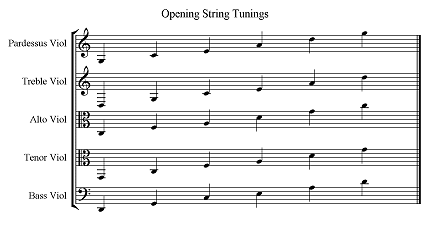 |
Treble Viol | more ...
sounds at written pitch |
Alto Viol | more ...
sounds at written pitch |
Tenor Viol | more ...
sounds at written pitch |
Lyra Viol | more ...
a small bass viol popular in England during the seventeenth century. It differed otherwise little from the standard bass viol. Its repertory, notated in tablature, is pre-dominantly polyphonic and played mainly with the bow. The sources include pieces for one lyra viol or more, and lyra viol accompaniment for songs, by composers such as Coprario, Jenkins, William Lawes and Tobias Hume. At least 60 different tunings have been noted. |
Division Viol | more ...
an English form of bass viola da gamba, used in the seventeenth century for performing free ornamentation by varying given melodies. It was the equivalent of the European viola bastarda, and was smaller than a consort bass viol but larger than a lyra viol. |
Bass Viol | more ...
sometimes a seventh string added tuned to A below bass clef
sounds at written pitch also sometimes called the 'Viola da Gamba' although strictly all viols are 'da gamba', that is they are played down on the lap or between the player's legs (gamba being the Italian for 'leg' |
Consort of Viols | more...
the viol consort was introduced to England in the early sixteenth century and was mainstay of domestic music until the middle of the seventeenth century. After the Restoration of Charles II to the throne in 1660, things rapidly changed with the rise in popularity of the violin amongst court musical lfe and amateurs.
Composers soon ceased to contribute to the viol consort repertory, with some of Purcell's contemporaries such as Roger North regretting the change. North acknowledged that the violin was 'very excellent in it's kind', but thought that the 'noble Base Viol' embodied all its 'sublimitys'.
As North recognised, the viol was not entirely supplanted by the violin in the Restoration period. The bass viol remained in use as a continuo instrument in chamber music until the early eighteenth century, and the instrument acquired a new repertory of solos, duet and trios with continuo.
|
Violone | more...
(Italian, literally 'large viol')
in modern terminology, the double bass viol, the direct ancestor of the double bass. Historically, the term has embraced a variety of meanings: any viol, a large viol (in particular a low-pitched viola da gamba), and even (in some Italian sources) the cello. The term is known as early as 1520.
|
Electric Viola da Gamba | more...
one of the most exciting extensions of this remarkable family of bowed stringed instruments, the Ruby Electric Viola da Gamba is a seven-string bass viol.
|
| 3 |
Plucked Strings |  | Guitar | more ...
sounds an octave below written pitch.
the guitar is a musical instrument, used in a wide variety of musical styles, and is also widely known as a solo classical instrument. It is most recognized in popular culture as the primary instrument in blues, country, flamenco, pop, and rock music. The guitar usually has six strings, but guitars with four, seven, eight, ten, and twelve strings also exist. Guitars are made and repaired by luthiers.
| 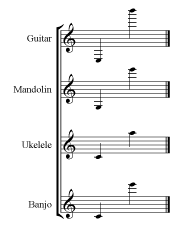 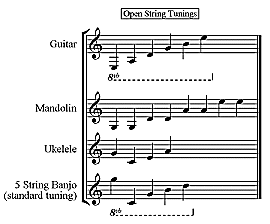 |
Lute | more ...
the name lute refers both to any plucked string instrument with a fretted neck and a deep round back and specifically to an instrument from the family of European lutes. Lute and oud both descend from a common ancestor, with diverging evolutionary paths. The words 'lute' and 'oud' may have derived from Arabic alud, "the wood", though recent research by Eckhard Neubauer suggests that ud may simply be an Arabized version of the Persian name rud, which meant string, stringed instrument, or lute. Gianfranco Lotti suggests that the "wood" appellation originally carried derogatory connotations, because of proscriptions of all instrumental music in early Islam. The player of a lute is called a lutenist, lutanist or lutist, and a maker of lutes (or any string instrument) is called a luthier.
For tuning information on the lute please refer here
The archlute is a lute with two pegboxes, the first being used for the main courses of strings (6 to 8 in number) that were played with the fingers of the left hand, and the second holding the longer strings, either courses or single strings, that were only played as open strings in the bass register. The archlute was particularly well adapted to continuo work, but nevertheless had a repertoire of solo pieces written for it. The archlute was the Italian baroque lute by definition.
The theorbo was apparently an extension of the archlute, its body being larger and the neck containing the second pegbox for the lower strings being even longer. The theorbo could reach a total of two metres in length. There were, however, various other differences, the theorbo often being strung with single strings and not in courses. Its tuning was also individual in that the first two strings were tuned an octave lower, this occurring because the main neckpiece was approximately 20 centimetres longer than that of the archlute. The third string was therefore the highest. Even though the instrument seems to have been almost specifically used for continuo work, there are some instances of its use as a solo instrument. |
Mandolin | more ...
sounds at written pitch
a mandolin is a small, stringed musical instrument which is plucked, strummed or a combination of both. It is descended from the mandora. It is characterized by:
- Eight metal strings in four pairs (courses) that are plucked with a plectrum,
- A body with a teardrop-shaped soundtable (i.e. face), or one that is essentially oval in shape,
- A neck with a flat (or slightly radiused) fretted fingerboard, and a nut and floating bridge,
- A tailpiece or pinblock at the edge of the face to which the strings are attached
- Mechanical tuning machines, rather than friction pegs,
- A soundtable with a soundhole, or soundholes, of varying shapes that are open and not latticed.
Although the most common tuning for the mandolin is in fifths, the same as for the violin (G-D-A-E, lowest to highest), guitarists may occasionally tune a mandolin to mimic a portion of the intervals on a standard guitar tuning to achieve familiar fretting patterns |
Ukelele/Ukulele | more ...
sounds at written pitch |
Five String Banjo | more ...
sounds an octave below written pitch |
Early and Modern Plucked & Fretted Instruments | more... |
| 4 |
Harp |  | Orchestral Harp | more ...
written on two staves
sounds at written pitch the pedal harp, or concert harp, is large and technically modern, designed for classical music and played solo, as part of chamber ensembles, and in symphony orchestras. It typically has six and a half octaves (46 or 47 strings), weighs about 80lb (36 kg), is approximately 6 ft (1.8 m) high, has a depth of 4 ft (1.2 m), and is 21.5 in (55 cm) wide at the bass end of the soundboard. The notes range from three octaves below middle C (or the D above) to three and a half octaves above, usually ending on G. Alexander Rannie adds: "since the majority of concert harps allow this top note to be
played as g-flat, g-natural, or g-sharp, the actual range of the harp is from c-flat at the bottom to g-sharp at the top" (private communication). The tension of the strings on the sound board is roughly equal to a ton (10 kilonewtons). The lowest strings are made of copper or steel-wound nylon, the middle strings of gut, and the highest of nylon. | 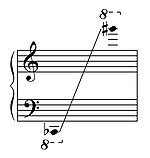 |
Celtic Harp | more... |
Baroque Harp | more... |
| 5 |
Flutes |  | Piccolo in C | more ...
sounds an octave above written pitch | 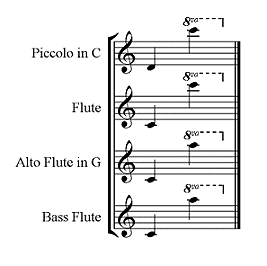 |
Piccolo in Db | more ...
sounds a minor 9th above written pitch
in band music, the Db piccolo, rather than the larger orchestral C piccolo, was the mainstay until the early twentieth century, when the Db parts were gradually transposed for the C piccolo because of its stronger tone. The Db piccolo however, retains the distinction of being the first woodwind instrument to be added to the American brass bands of the mid-nineteenth century |
Flute in C | more ...
sounds at written pitch
[Cindy Pedder has written to point out that some flutes can actually play the B natural below middle C - this is achieved by using an extended foot-joint that pushes the range downwards a further semitone (from C down to B natural) - in every other regard the C flute with the low B extension follows the standard C flute fingering throughout the rest of the instrument's range] |
Flute in Eb | more ...
the Eb soprano flute or Terzflöte is somewhat smaller and sounds a minor third higher than the C flute. This less well known member of the flute family was originally used in U.S. public school bands as a substitute for the more expensive Eb clarinet from approximately the 1940s through the early 1970s as well as a beginner flute for students with very small hands. Since its tone color and range was unlike that of the Eb clarinet, and since most beginners were either able to handle the C flute without problems or else buy one with a curved headjoint, manufacturers stopped making them around 1980. However, due to the popularity of flute choirs, one U.S. manufacturer (Emerson) began to make them again in 1991, as there are more and more pieces of flute choir music that require the instrument. Its distinctive tone color, sounding sweeter than the C flute and more mellow than the piccolo, makes the Eb flute a unique member of the flute family whose potential is yet to be fully explored. Cindy Pedder writes, 'Playing a soprano flute usually means the flutist is playing in the sharp keys, something we don't often encounter when playing a C flute in a band.'Cindy notes also that the Emerson company stopped making the Eb flute several years ago. Cindy continues, "I know this because I purchased one of the last Eb flutes they made, and no one (to my knowledge) is making them now. I can't tell you how many people have offered to buy my little soprano flute, because the only ones you can buy now are used flutes. And since most of those were used in school bands, they are not in good shape! Flute choirs are big here in the States, and while not a lot of music is written for Eb flute, it is nice to have a voice between the flute and the piccolo, just as it is nice to have the alto between the flute and the bass." |
Alto Flute in G | more ...
sounds a perfect fourth below written pitch |
Flûte d'amour in Bb | more ...
the modern tenor flute, also known in the nineteenth century as the flûte d'amour or alto flute in Bb, is pitched one step below the C flute. It has the same fingering range as the C flute but sounds its best in the middle and low registers. It has a much stronger sound in the low register than the C flute and is, therfore, useful for transposing extremely low C flute parts to provide a better balance in orchestral or ensemble playing. Tenor flutes are currently made by Emerson and Altus and come in both closed and open hole models; however, with its somewhat larger tubing and wider-spaced keys, the closed-hole model is probably easier to play. Tenor flutes today are extremely rare and generally are only used for jazz as they are in the same key as tenor saxophones and clarinets, making it easier for the jazz musician to double on all three instruments |
Bass Flute | more ...
sounds an octave below written pitch |
Renaissance Flute | more... |
Baroque Flute | more ... |
Classical Flute | more ... |
Historical Flutes: general information
Rick Wilson's Historical Flute Page |
| 6 |
Clarinets |  |
Piccolo, Octave and Sopranino Clarinets | more ... | 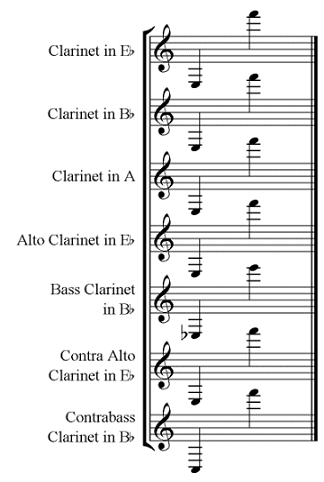 |
Clarinet in E flat | more ...
sounds a minor third higher than written pitch |
Clarinet in B flat | more ...
sounds a major second below written pitch |
Clarinet in A | more ...
sounds a minor third lower than written pitch |
Alto Clarinet in E flat | more ...
sounds a major sixth lower than written pitch |
Bass Clarinet in B flat | more ...
sounds one octave below the Clarinet in B flat |
Contra Alto Clarinet in E flat | more ...
sounds one octave below the Alto Clarinet in E flat |
Contra Bass Clarinet in B flat | more ...
sounds one octave below the Bass Clarinet in B flat |
Clarinet Family | more ...
the clarinet has a distinctive timbre, resulting from the shape of the cylindrical bore, whose characteristics vary between its three main registers: the chalumeau (low), clarion or clarino (middle), and altissimo (high). It has a very wide compass, which is showcased in chamber, orchestral, and wind band writing. The tone quality varies greatly with the musician, the music, the style of clarinet, the reed, and humidity. The German (Oehler) clarinet generally has a darker tone quality than the French (Boehm) system. In contrast, the French clarinet typically has a lighter, brighter tone quality. The differences in instruments and geographical isolation of players in different nations led to the development, from the last part of the eighteenth century on, of several different schools of clarinet playing. The most prominent of these schools were the German/Viennese traditions and the French school, centred around the clarinettists of the Conservatoire National Supérieur de Musique de Paris. Increasingly, through the proliferation of recording technology and the internet, examples of many different styles of clarinet playing are available to developing clarinettists today. This has led to decreased homogeneity of styles of clarinet playing. The modern clarinetist has an eclectic palette of "acceptable" tone qualities to choose from, especially when working with an open-minded teacher |
| 7 |
Saxophones |  | Sopranissimo Saxophone in B flat
construction difficulties mean that only recently has a true sopranissimo saxophone been produced. Nicknamed the "soprillo," this piccolo-sized saxophone is an octave above the soprano, and its diminutive size necessitates an octave key on the mouthpiece
| 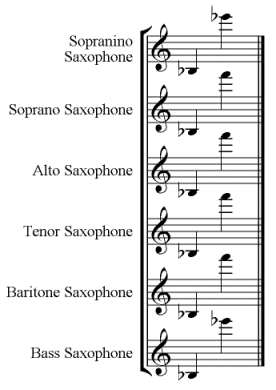 |
Sopranino Saxophone in E flat
sounds a minor third above written pitch |
Soprano Saxophone in B flat
sounds a major second below written pitch |
Alto Saxophone in E flat
sounds a major sixth below written pitch |
Tenor Saxophone in B flat
sounds a major ninth below written pitch
|
Baritone Saxophone in E flat
sounds one octave plus a major sixth below written pitch |
Bass Saxophone in B flat
sounds one octave plus a major ninth below written pitch |
Saxophone Family | more ...
the saxophone was originally patented as two families, each of seven instruments. The "orchestral" family consisted of instruments in the keys of C and F, and the "band" family in Eb and Bb. Each family consisted of Sopranino, Soprano, Alto, Tenor, Baritone, Bass and Contrabass although some of these were never made (Sax also planned - but never made - a subcontra).
Of these the orchestral family are now rarely found, and of the band family only the soprano, alto, tenor and baritone are in common use (these form the typical saxophone sections of both military and big bands). The C-melody saxophone, a non-transposing instrument, was popular in the 1920s and could be played from sheet music for guitar and piano. The soprano has regained a degree of popularity over recent decades, and the bass, sopranino and even contrabass are still manufactured. Sopranino, bass and contrabass are rarely used except in large saxophone ensembles and saxophone orchestras.
The wide bore of the saxophone means that the larger saxes are extremely large and heavy, and recently (1999) an alternative contrabass, the "tubax," has been developed with a narrower bore. Although not a true saxophone, its bore leads to a more reasonable size and weight. |
| 8 |
Double Reeds |  | Oboe | more ...
sounds at written pitch the baroque oboe as it was used at the end of the seventeenth century had its origin in such Renaissance instruments as the bombards, the shawms and the pifferi. Originally one of a family of instruments, the soprano oboe was the principal oboe that was still in use at the end of the seventeenth century. As was also the case with practically every other woodwind instrument at that time, its conical bore became narrower and its exterior became increasingly elaborate (cf. the recorder) with decorative mouldings and circlets. It was at first an orchestral instrument, particularly so in France but it soon went on to establish its own repertory in chamber music and sacred music. The oboe was also very popular in Italy, while J.S. Bach was to make it one of the instruments he used most frequently for obbligato lines in his cantata arias. The two keys are used to overcome a limitation of fingering (for the low C) and to improve the quality of a note in the lower register (for the E flat) | 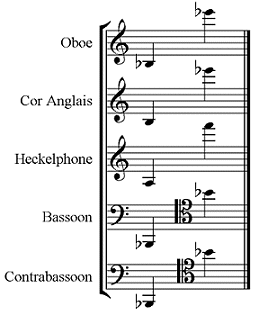 |
Oboe d'amore in A | more ...
sounds a minor third below written pitch this is a typically German instrument that dates from the first half of the eighteenth century, it being an oboe in A that sounds a third lower than the normal oboe. It also possesses a bell shaped bulge at its lower end that gives the instrument its characteristically warm timbre. It was mainly used as a solo instrument in chamber music although J.S. Bach also used it as an obbligato instrument in cantata arias. |
Cor Anglais in F (English Horn) | more ...
sounds a perfect fifth lower than written pitch the baroque equivalent of the cor anglais was the alto oboe known in France as the taille de hautbois. It was first used in the second half of the seventeenth century in the French ensembles known as the bandes de hautbois, in which it played the inner lines of polyphonic compositions. J.S. Bach was also to make use of it when a low pitched oboe was needed to double the viola parts in the cantatas.
The oboe da caccia, always referred to by its Italian name, appears frequently in works by J.S. Bach. It is also quite probable that Bach himself caused this particular type of oboe to be built. Several years ago various pieces of an instrument were discovered in the collections of the Copenhagen Instrumental Museum; these were carefully assembled and this enigmatic instrument was the result. It had a double reed, it was bigger than the normal oboe and had a curved body whose separate components were held together by a strip of leather, the whole ending in a metallic bell. What was more, it was noted with great surprise that the instrument had been first made by Eichentopf, the most well-known instrument maker of Leipzig of Bach's time. The puzzle over exactly what type of instrument Bach's oboe da caccia was had finally been solved. The oboe da caccia sounds a fifth lower than the normal oboe and can thus be linked with the alto oboe in F |
Heckelphone in C | more ...
sounds one octave below written pitch the Heckelphone was a musical instrument invented by Wilhelm Heckel and introduced in the late nineteenth century. It is similar to a oboe but with a wider bore and a deeper sound. Richard Strauss's 1905 opera Salome calls for a Heckelphone |
Piccolo Heckelphone in F
the piccolo Heckelphone is a very rare woodwind instrument. It is a variant of the Heckelphone, that is pitched in F, a fourth above the oboe. It was developed and produced by the Wilhelm Heckel GmbH in Biebrich, Germany |
Bassoon | more ...
sounds at written pitch the precursor of the modern bassoon, the dulcian (meaning soft and sweet in Latin) was invented about 500 years ago. It was built in one piece and had a double reed made from cane. In England the dulcian was called the curtal. In the period 1643 to 1715, French instrument makers developed a new curtal that had four separate pieces and between 4 and 8 keys. It is remarkably similar to the modern instrument. During the 1700s, more keys were added as the range was extended. The most important change came in 1820 when Carl Almenader and his partner, Adam Heckel, developed a bassoon with a better sound. Their design, the German bassoon, is the model most often used today |
Contrabassoon
sounds one octave below written pitch |
| 9 |
Trumpets |  | Piccolo Trumpet in A
sounds a major sixth above written pitch |  |
Trumpet in F
sounds a perfect fourth above written pitch |
Trumpet in E
sounds a major third above written pitch |
Trumpet in E flat
sounds a minor third above written pitch |
Trumpet in D
sounds a major second above written pitch |
Trumpet in C
sounds at written pitch |
Trumpet in B (rare)
sounds a minor second below written pitch |
Trumpet in B flat (Cornet)
sounds a major second below written pitch |
Trumpet in A
sounds a minor third below written pitch |
Flugelhorn in B flat
played with a trumpet mouthpiece: sounds a major second below written pitch (range shown in the horn section below) [corrected by Stew King] |
Bass Trumpet in E flat
sounds a major sixth below written pitch |
Bass Trumpet in C
sounds one octave below written pitch |
Bass Trumpet in B flat
sounds a major ninth below written pitch |
Trumpet Family | more ...
the first trumpets reputedly came from Egypt, and were primarily used for military purposes (Joshua's shofar, blown at the battle of Jericho, came from this tradition) like the bugle as we still know it, with different tunes corresponding to different instructions. In medieval times, trumpet playing was a guarded craft, its instruction occurring only within highly selective guilds. The trumpet players were often among the most heavily guarded members of a troop, as they were relied upon to relay instructions to other sections of the army. Eventually the trumpet's value for musical production was seen, particularly after the addition of valves around the mid 1830s, and its use and instruction became much more widespread. The Arabic word for trumpet was naffir. The Spanish used the Arabic name al naffir and changed it into anafil, while the French gave the trumpet its own name, buisine, derived from the Latin word buccina |
| 10 |
Trombones |  | Alto Trombone in E flat
sounds at written pitch | 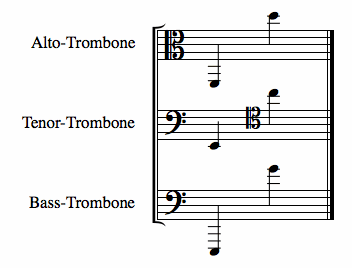 graphic provided by Raphael Vang |
Tenor Trombone in B flat
sounds at written pitch |
Bass Trombone in B flat
sounds at written pitch |
Trombone Family | more ...
until the early eighteenth century, the trombone was called the sackbut in English, a word with various different spellings ranging from sackbut to shagbolt and derived from the Spanish sacabuche or French sacqueboute. This was not a distinct instrument from the trombone, but rather a different name used for an earlier form. Other countries used the same name throughout the instrument's history, viz. Italian trombone and German Posaune. The sackbut was built in slightly smaller dimensions than modern trombones, and had a bell that was more conical and less flared. Today, sackbut is generally used to refer to the earlier form of the instrument, commonly used in early music ensembles. Sackbuts were (and still are) made in every size from alto to contrabass, though then as now the contrabass is very rare. Older, now obsolete versions of the bass trombone were of smaller bore than the modern bass trombone described above. They were pitched in G (range: Db2-D5, without attachments), F (range: B2-C5), E (Renaissance, Baroque instruments) , E flat (range: A2-Bb5), D (Renaissance, Baroque instruments) or C (Renaissance, Baroque instruments) and had a longer slide and a handle attached to the outer slide stay to allow for full extension of the slide. These older types of bass trombone were used in Europe and the British Empire
[some information taken from: Types of Trombone] |
| 11 |
Horns |  |
French Horn in F | more ...
sounds a perfect fifth below written pitch the two terms, Hunting Horn and Trompe de Chasse are both often used for the same instrument. The trompe de chasse first came to prominence at the end of the seventeenth century in France; the French court's behaviour was much imitated at the time and the instrument thus became part of European hunting tradition. The hunting horn came in various sizes, depending on how many concentric circles were formed by the body of the instrument. This instrument that is so characteristic of the hunt and the countryside began to be used in instrumental music at the beginning of the eighteenth century, as can be seen from French and German works of the period, Bach's 1st Brandenburg Concerto being one of the most famous examples. In this work and in many others for the instrument by Bach's contemporaries, the instrument is called the corno da caccia. Like the trumpet, the horn is limited in its melodic ability because of its reliance on the harmonic series, although a few more notes are nevertheless available; it has the same intonation problems as the trumpet in this respect. This problem was, however, solved during the eighteenth century around 1750 by one Anton Joseph Hampel, who discovered the stopped note technique. This consists of placing the hand into the bell of the horn, thus changing the length of the column of air and thereby correcting the tuning of certain notes and even obtaining several that do not form part of the natural harmonic scale. There is no mention of this technique in any source prior to this date, either in scores, essays, or paintings which could lead us to believe either that the players of Bach's, Handel's and Telemann's works had a special lip technique or that what appear to us today to be intonation faults were then accepted because they were an unavoidable part of the instrument. This being said, it seems that the instrument that was used for "learned" music then began slowly to differ from the hunting horn proper. The shape of the bell changed, its progressive widening making Hampel's technique possible. A system of crooks was also invented that enabled the instrument to be played in different keys (also sometimes used for the trumpet), these crooks being different lengths of tubing that were inserted between the mouthpiece and the body of the instrument, thereby varying the fundamental pitch of the instrument (C, D, E, F, G etc.) according to their length and allowing the horn to play many different types of music. It was undoubtedly for reasons of balance with other instruments that the horn's timbre softened and darkened in contrast to the brassy and brilliant colour of the trumpet, which had to keep its bright and loud tone for obvious reasons. | 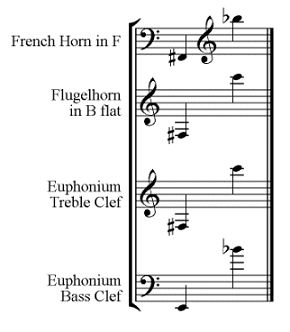 |
Alto Horn in B flat (rare)
sounds a major second below written pitch [corrected by Stew King] |
Alto Horn in A
sounds a minor third below written pitch |
French Horn in G
sounds a perfect fourth below written pitch |
French Horn in E
sounds a minor sixth below written pitch |
French Horn in E flat
sounds a major sixth below written pitch |
French Horn in D
sounds a minor seventh below written pitch |
French Horn in C
sounds an octave below written pitch |
Wagner Tubas
Bass Clef
usually played by members of the horn section with a French Horn mouthpiece (range is shown against the tuba in the section below) [corrected by Stew King] |
| 12 |
Tubas |  | B flat Tenor Wagner Tuba
not a true tuba: played by members of the French Horn section with a French Horn mouthpiece: sounds a major second below written pitch [corrected by Stew King] | 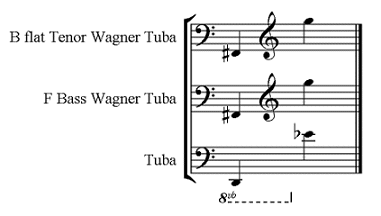 |
F Bass Wagner Tuba
not a true tuba: played by members of the French Horn section with a French Horn mouthpiece: sounds a perfect fifth below written pitch [corrected by Stew King] |
Baritone Horn (Euphonium)
Treble Clef
member of the tuba family: sounds a major ninth below written pitch (range shown in the horn section above) [corrected by Stew King] |
Baritone Horn (Euphonium)
Bass Clef
member of the tuba family: sounds at written pitch (range shown in the horn section above) [corrected by Stew King] |
Tuba | more ...
sounds at written pitch tubas are found in various pitches, most commonly in F, Eb, C, or Bb in "brass band" pitching. The main bugle of Bb tubas is approximately 18 feet long, while C tubas are 16 feet, Eb tubas 13 feet, and F tubas 12 feet in tubing length without adding any valve branches. Tubas are considered to be conical in shape as from their tapered bores, they steadily increase in diameter along their lengths. If the tubing is wrapped for placing the instrument on the player's lap, the instrument is usually called a tuba or concert tuba. It may have a bell pointing forward instead of upward, in which case it is often called a recording tuba because of its popularity in the early days of recorded music. When wrapped to surround the body for marching, it is traditionally known as a helicon. A sousaphone is a helicon with a bell pointed up, or then curved to point forward (really, a recording sousaphone). |
| 13 |
Tuned
Percussion |  | Timpani | more ...
sounds at written pitch
timpani are musical instruments in the percussion family. A type of drum, they consist of a skin called a head stretched over a large bowl commonly made of copper. They are played by striking the head with a specialized drum stick called a timpani stick or timpani mallet. Unlike most drums, they produce a definite pitch when struck. Timpani evolved from military drums to become a staple of the classical orchestra in the seventeenth century. Today, they are used in many types of musical ensembles including concert, marching, and even rock bands. Timpani is an Italian plural, the singular of which is timpano. However, this is rarely used in informal English speech as a timpano is typically referred to as a drum, a timpani, or simply a timp. Alternative spellings with y in place of either or both is tympani, tympany, or timpany are occasionally encountered in older English texts. This substitution is taken from the Latin word tympanum, from which the Italian word descends. A musician who plays the timpani is known as a timpanist. While the word timpani has been widely adopted in the English language, some English speakers choose to use the native word kettledrums. The German word for timpani is Pauken, and the French is timbales
|  |
Glockenspiel | more ...
sounds two octaves above written pitch
the Glockenspiel (German, "play of bells", also known as orchestra bells and, in its portable form, bell lira or bell lyre) is a musical instrument in the percussion family. It is similar to the xylophone, in that it has tuned bars laid out in a fashion resembling a piano keyboard. The xylophone's bars are wooden, while the glockenspiel's are metal, thus making it a metallophone. The glockenspiel, moreover, is much smaller and higher in pitch. When used in a marching or military band, the bars are sometimes mounted in a portable case and held vertically. In orchestral use, the bars are mounted horizontally. A pair of hard mallets is generally used to strike the bars, although if laid out horizontally, a keyboard may be attached to the instrument to allow chords to be more easily played. The glockenspiel's range is limited to the upper register, and usually covers about two and a half to three octaves. In sheet music, the notes to be played by the glockenspiel are written two octaves lower than they will sound when played. When struck, the bars give a very pure, bell-like sound.
|
Xylophone | more ...
sounds one octave above written pitch
the xylophone (from the Greek meaning 'wooden sound') is a musical instrument in the percussion family which probably originated in Indonesia (Nettl 1956, p.98). It consists of wooden bars of various lengths that are struck by a plastic, wooden, or rubber mallet. Each bar is tuned to a specific pitch of the scale Xylophones are tuned to different scale systems depending on their origin, including pentatonic, heptatonic, diatonic, or chromatic. The arrangement of the bars is generally from low (longer bars) to high (shorter bars). The xylophone has a brighter tone than its cousin the marimba, and the sustaining power of the notes is dependednt upon the material the keys are made of. Modern xylophones include resonating tubes below the bars. A xylophone with a range extending downwards into the marimba range is called a xylorimba.
|
Vibraphone | more ...
sounds at written pitch
|
Tubular Bells | more ...
sounds at written pitch |
Marimba | more ...
sounds at written pitch |
| 14 |
Voices |  | Soprano
sounds at written pitch (see music dictionary for information about different kinds of soprano voice) | 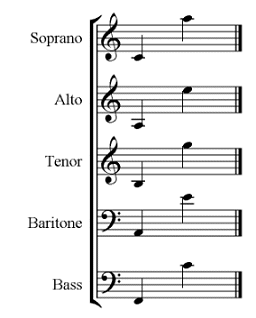 |
Mezzo-soprano
with a range from A below middle C to F an eleventh above middle C, mezzo-sopranos generally have a darker (or lower) vocal tone than sopranos, and their vocal range is between that of a soprano and that of an alto. The terms Dugazon and Galli-Marié are sometimes used to refer to light mezzo-sopranos, after the names of famous singers. A castrato with a mezzo-soprano voice was called a mezzo-soprano castrato |
Alto (Contralto)
sounds at written pitch (see music dictionary for information about different kinds of contralto voice: alto here refers to the lowest female voice) |
Castrato
a male voice with the same range as a female soprano (see music dictionary for more information) |
Countertenor
a falsetto male voice with the same range as a female alto (contralto) (see music dictionary for more information) |
Tenor
sounds one octave below written pitch (see music dictionary for information about different kinds of tenor voice) |
Baritone
sounds at written pitch (see music dictionary for information about different kinds of baritone voice) |
Bass
sounds at written pitch (see music dictionary for information about different kinds of bass voice) |
| 14 |
Recorders |  | Sopranino in F
sounds one octave above written pitch | 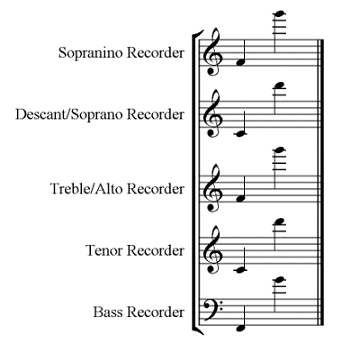 |
Descant (Soprano) in C
sounds one octave above written pitch |
Treble (Alto) in F
sounds at written pitch |
Tenor in C
sounds at written pitch |
Bass in F
sounds one octave above written pitch |
Recorder Family | more ...
the recorder is a woodwind musical instrument of the family known as fipple flutes or internal duct flutes, whistle-like instruments which include the tin whistle and ocarina. The recorder is end-blown and the mouth of the instrument is constricted by a wooden plug, known as a block or fipple. It is distinguished from other members of the family by having holes for seven fingers (the lower one or two often doubled to facilitate the production of semitones) and one for the thumb of the uppermost hand. The bore of the recorder is occasionally cylindrical but is usually tapered slightly, being widest at the mouthpiece end.
recorder ranges, clefs and other useful information by Ann Bies |
| 15 |
Keyboard
Instruments |  |
Organ | more ...
the best known member of this family is the pipe organ, so named because it produces its sound through pipes, although many people simply refer to it as the "organ". Other types include the electronic organ, which does not have pipes, is technically not an organ, and propagates its electronically-produced sound through one or more loudspeakers. Mechanical, electro-pneumatic and electro-mechanical actions exist that allow the organist to play any or all of the stops on an organ, giving him the ability to change not only colour, but also pitch level, at will. The pipe organ is the origin of the terms 8', 16', 32', etc.. Originally referencing the length of a pipe in feet, the terms are now commonplace on synthesizer oscillators, referring to relative pitch levels. 8' stops sound pitches where you would expect when played on the piano. 16' stops play an octave lower, 32' two octaves lower, 4' and 2' stop play one and two octaves higher, respectively, in essence making the pipe organ a transposing instrument, as well. While these pitch level indications are familiar to today's synthesizer users, some stops, generally called mutations, are also made that incorporate pitch levels other than octaves, such as 5 1/3' (5th higher), 3 1/5' (10th higher) or 2 2/3' (12th higher). Most pipe organs these days have at least three manuals (keyboards), though some have only two or as many as four or five (a few even six or seven), and of course they have pedals, as well. Manuals usually comprise 61 keys notated C to c4, while the pedals usually encompass 32 notes, notated C to g1.? Notice I said "notated", because as I mentioned before, you might specify 16' or 4' stops, which would change the pitch that actually sounds.
[reference: Organ Tutorial from which most of this extract has been taken]
|
Pianoforte | more ...
a piano or pianoforte is a musical instrument classified as a keyboard, percussion, or string instrument, depending on the system of classification used. The piano produces sound by striking steel strings with felt hammers that immediately rebound allowing the string to continue vibrating. These vibrations are transmitted through the bridges to the soundboard, which amplifies them. The piano is widely used in western music for solo performance, chamber music, and accompaniment. It is also very popular as an aid to composing and rehearsal. Although not portable and often expensive, the piano's versatility and ubiquity has made it among the most familiar of musical instruments. The word piano is a shortened form of the word pianoforte, which is seldom used except in formal language and derived from the original Italian name for the instrument, gravicèmbalo col piano e forte (literally harpsichord with soft and loud). This refers to the ability of the piano to produce notes at different volumes depending on the amount of force used to press the keys
|
Harpsichord | more ...
a harpsichord is any of a family of European keyboard instruments, including the large instrument currently called a harpsichord, but also the smaller virginals, the muselar virginals and the spinet. All these instruments generate sound by plucking a string rather than striking one, as in a piano or clavichord. The harpsichord family is thought to have originated when a keyboard was affixed to the end of a psaltery, providing a mechanical means to pluck the strings. The type of instrument now usually called a harpsichord in English is generally called a clavicembalo or simply cembalo in Italian, and this last word is generally used in German as well. The typical French word is clavecin. Confusingly, the most commonly used Spanish word for a harpsichord is clavicordio, leading to confusion with the clavichord. Accordingly, in musical circles the Italian or, more commonly, the French word is used by Spanish speakers
|
|
Clavichord | more ...
the clavichord is a European stringed keyboard instrument known from the late Medieval, through the Renaissance, Baroque and Classical eras. Historically, it was widely used as a practice instrument and as an aid to composition. The clavichord produces sound by striking brass or iron strings with small metal blades called tangents. Vibrations are transmitted through the bridge(s) to the soundboard. The name is derived from the Latin word 'clavis', meaning "key" and 'chordis' meaning string
|
|
|
Instrument Names in Other Languages
::

|
Key word:
instrument names |
| 1 |
Instrument Names in Other Languages
| English | Italian | German | French | Spanish |
| musical instruments | strumenti musicali | Musikinstrumente | instruments de musique | instrumentos musicales |
| wind instruments | strumenti a fiato | Blasinstrumente | instruments à vent | instrumentos de viento |
| woodwind instruments | legni | Holzblasinstrumente | instruments à vent en bois | instrumentos de madera |
| recorder | flauto dolce
flauto dritto
flauto a becco | Blockflöte | flûte à bec
flûte douce
flûte droite | flauta recta
flauta dulce
flauta de pico |
| sopranino recorder | flauto dolce sopranino
flauto dritto sopranino
flauto a becco sopranino | Sopraninoblockflöte | flûte à bec sopranino
flûte douce sopranino
flûte droite sopranino | flauta recta sopranino
flauta dulce sopranino
flauta de pico sopranino |
descant recorder (UK)
soprano recorder (US) | flauto dolce soprano
flauto dritto soprano
flauto a becco soprano | Sopranblockflöte | flûte à bec soprano
flûte douce soprano
flûte droite soprano | flauta recta soprano
flauta dulce soprano
flauta de pico soprano |
treble recorder (UK)
alto recorder (US) | flauto dolce contralto
flauto dritto contralto
flauto a becco contralto | Altblockflöte | flûte à bec alto
flûte douce alto
flûte droite alto | flauta recta contralto (or alto)
flauta dulce contralto (or alto)
flauta de pico contralto (or alto) |
| tenor recorder | flauto dolce tenore
flauto dritto tenore
flauto a becco tenore | Tenorblockflöte | flûte à bec ténor
flûte douce ténor
flûte droite ténor | flauta recta tenor
flauta dulce tenor
flauta de pico tenor |
| bass recorder | flauto dolce basso
flauto dritto basso
flauto a becco basso | Bassblockflöte | flûte à bec basse
flûte douce basse
flûte droite basse | flauta recta bajo
flauta dulce bajo
flauta de pico bajo |
piccolo
octave flute | ottavino
flauto piccolo
ottavino | kleine Flöte
Pikkoloflöte
Piccolo | petite flûte
flûte piccolo | ottavino
flautín
octavillo
flauta piccolo |
| sopranino flute | flauto sopranino | Sopraninoflöte | flûte sopranino | flauta sopranino |
soprano flute
third flute (in E flat) | flauto traverso terzetto (in E flat)
(occasionally) flauto soprano (in G) | Terzflöte (in E flat)
Terzquerflöte (in E flat) | flûte à (la) tierce (in E flat)
flûte tierce (in E flat) | flauta soprano (in E flat) |
flute (flutes)
transverse flute | flauto (flauti)
flauto traverso | Flöte (Flöten)
Querflöte | flûte (flûtes)
flûte traversière
grande flûte | flauta (flautas)
flauta travesera
flauta de Boehm
flauta de concierto
flauta traversa |
alto flute
(in English, the contralto flute is an instrument one octave below the alto flute) | flauto contralto | Altflöte | flûte alto
flûte en sol | flauta alto
flauta en sol |
tenor flute
flute d'amore
(although the latter term is used for a number of different sizes of flute) | flauto tenore
flauto d'amore
(although the latter term is used for a number of different sizes of flute) | Tenorflöte
Flöte d'amore
(although the latter term is used for a number of different sizes of flute) | flûte tenor
flûte d'amour
(although the latter term is used for a number of different sizes of flute) | flauta tenor
flauta de amor
(although the latter term is used for a number of different sizes of flute) |
| bass flute | flauto basso | Bassflöte | flûte en ut
flûte basse | flauta bajo |
| oboe (oboes) | oboe (oboi) | Oboe (Oboen)
Hoboe | hautbois | oboe (oboes) |
English horn (U.S.)
cor anglais (U.K.) | corno inglese | Englischhorn | cor anglais | corno inglés
cuerno inglés
corneta inglesa |
| oboe d'amore | oboe d'amore | Liebesoboe
Oboe d'amore | hautbois d'amour | oboe de amor |
| clarinet (clarinets) | clarinetto (clarinetti) | Klarinette (Klarinetten) | clarinette (clarinettes) | clarinete (clarinetes) |
| soprano clarinet | clarinetto piccolo | kleine Klarinette | petite clarinette | clarinete soprano |
| alto clarinet | clarinetto contralto | Altklarinette | clarinette alto | clarinete alto |
| basset horn | corno di bassetto | Bassetthorn | cor de basset | cuerno basset
trompa de basset |
| bass clarinet | clarinetto basso | Bassklarinette | clarinette basse | clarinete bajo |
| contra or double bass clarinet | clarinetto contrabbasso | Kontrabassklarinette | clarinette contrebasse | clarinete contrabajo |
| bassoon (bassoons) | fagotto (fagotti) | Fagott (Fagotte) | basson (bassons) | fagot |
| contrabassoon (contrabassoons) | contrafagotto (contrafagotti) | Kontrafagott (Kontrafagotte) | contrebasson (contrebassons) | contrafagot |
| Heckelphone | Heckelphon
Heckelfono | Heckelfon | Heckelphone | Heckelfón |
| Sarrusophone | Sarrusofono | Sarrusofon | Sarrusophone | Sarrusofón |
| serpent | serpentone | Serpent
Schlangenbass | serpent | serpentón |
| saxophone (saxophones) | sassofono (sassofoni)
saxofono
sax | Saxophon (Saxophone) | saxophone (saxophons) | saxofón (saxofóns)
saxofóno |
| sopranino saxophone | sassofono sopranino | Sopraninosaxophon | saxophone sopranino | saxofóno sopranino |
| soprano saxophone | sassofono soprano | Sopransaxophon | saxophone soprano | saxofóno soprano |
| alto saxophone | sassofono contralto
sassofono alto | Altsaxophon | saxophone alto | saxofóno alto |
| tenor saxophone | sassofono tenore | Tenorsaxophon | saxophone ténor | saxofóno tenor |
| baritone saxophone | sassofono baritono | Baritonsaxophon | saxophone baryton | saxofóno barítono |
| bass saxophone | sassofono basso | Basssaxophon | saxophone basse | saxofóno bajo |
| contrabass saxophone | sassofono contrabbasso | Kontrabasssaxophon | saxophone contrebasse | saxofóno contrabajo |
| subcontrabass saxophone | sassofono subcontrabbasso | Subkontrabassaxophon | saxophone sous-contrebasse | saxofóno subcontrabajo |
| brass instruments | ottone | Blechblasinstrumente | instruments à vent de cuivres
(or cuivres) | instrumentos de viento-metal |
| French horn (French horns) | corno (corni)
corno francese | Horn (Hörner) | cor (cors)
cor d'harmonie
cor français | trompa (de pistones) (trompas (de pistones))
corno francés (cornos francese) |
posthorn
post-horn
post horn
coach horn | corno di postiglione
corno postale | Posthorn | cor postal
cor de postillon
cornet postal | corneta de posta
trompa de postillón
corneta de postillón
trompa de posta |
| natural horn | corno naturale | Waldhorn | cor simple | trompa natural |
| hunting horn | corno da caccia | Jagdhorn
Signalhorn | cor de chasse
bugle | trompeta de caza |
| valve horn | corno ventile
corno cromatico | Ventilhorn | cor à pistons
cor chromatique | trompa de pistones |
Alphorn
Alpenhorn
alpine horn | corno delle Alpi | Alphorn | cor des Alpes | trompa de los Alpes
alforn |
| cow horn | corno di toro | Stierhorn | cor de vache | cuerno de vaca |
| trumpet (trumpets) | tromba (trombe) | Trompete (Trompeten) | trompette (trompettes) | trompeta (trompetas) |
| natural trumpet | tromba naturale | Naturtrompete | trompette naturelle | trompeta natural |
| valve trumpet | tromba a pistoni | Ventiltrompete | trompette à pistons | trompeta de pistones |
| slide trumpet | tromba a tirarsi
tromba a tiro | Zugtrompete | trompette à coulisse | trompeta de vara |
| bass trumpet | tromba basso | Basstrompete | trompette basse | trompeta bajo
trompeta baja |
| cornet (cornets) | cornetta (cornetti)
(bugle or cornet)
cornetta a pistoni
(valve cornet) | Kornett (Kornette)
Ventilkornett
Piston | cornet (cornets)
cornet à pistons
(valve cornet) | cornetín
(corneta = bugle)
cornetín de pistones
(valve cornet) |
| trombone (trombones) | trombone (tromboni) | Posaune (Posaunen) | trombone (trombones) | trombón (trombons) |
| slide trombone | trombone a tiro | Zugposaune | trombone à coulisse | trombón de vara |
| valve trombone | trombone a pistoni | Ventilposaune | trombone à pistons | trombón de pistones |
| bass trombone | trombone basso | Bass Posaune | basse-trombone
trombone basse | trombón bajo |
contrabass trombone
double bass trombone | trombone contrabbasso | Kontrabassposaune | trombone contrabasse | trombón contrabajo |
| tuba (tubas) | tuba | Tuba | tuba (tubas) | tuba (tubas) |
| bass tuba | tuba bassa | Basstuba | tuba basse | tuba bajo |
| helicon | elicon
helicon | Helikon
Helikontuba | hélicon | helicón |
| crumhorn | cromorno | Krummhorn | cromorne | cromorno |
dulcian
curtal | dulciana | Dulzian | douçaine | bajón |
| oficleide | ophicleide | Ophikleide | ophicléide | oficleido |
| serpent | serpentone | Serpent
Schlangenbass | serpent | serpentón |
| ocarina | ocarina | Okarina | ocarina | ocarina |
pan pipe
pan flute
panpipes
panflute | flauto di Pan
siringa | Panflöte
Hirtenflöte
Syrinx
Papagenopfeife | flûte de Pan
syrinx | zampoñas
flautas de Pan
siringa |
| bagpipe | cornamusa
zampogna | Sackpfeife
Dudelsack | cornemuse
biniou | gaita |
mouth organ
harmonica | armonica a bocca | Mundharmonika | harmonica | armónica de boca |
| percussion instruments | batteria
strumenti a percussione
stromenti a percossa
stromenti da percossa
percussione | Schlagzeug
Schlaginstrument
Perkussionsinstrument | batterie
instruments à percussion | instrumentos de percusión
percusión
batería |
steel drum
steel pan(s)
pan(s) | tamburo d'acciaio | Stahltrommel | tambour d'acier | tambor metálico de Trinidad y Tobago |
| drum | tamburo | Trommel | tambour | tambor |
| side drum | tamburo
tamburo (piccolo)
piccolo cassa | kleine Trommel | tambour
caisse claire | tambor |
| snare drum | cassa chiara | kleine Trommel
Rührtrommel
Marschtrommel
Schnarrtrommel | tambour
caisse claire | caja clara
redoblante |
kettle drums
timpani | timpani | Pauken | timbales | timbales |
| piccolo snare drum | tamburo acuto
tamburo piccolo
tarole | Pikkolotrommel
Tarole | petit tambour | tarol |
military snare drum
field drum | tamburo militare | Militärtrommel
Rührtrommel | tambour militaire | tambor militar |
| tenor drum | cassa rullante
tamburino
tamburo rullante | Rührtrommel
Wirbeltrommel
Tenortrommel | caisse roulante
tambourin | caja rodante
caja redoblante
tambor mayor |
bass drum
Turkish drum | (Gran) cassa
tamborone
tamburo grande
tamburo grosso
gran cassa | Grosse Trommel | grosse caisse
tambour bata | bombo
gran caja |
tabor
tabret | tamburo | Tambourin | tambour de provence
tambourin | tamboril |
djembe
jembe
jenbe
djimbe
ymbe
yembe
jimbay
sanbanyi | djembe
djembè
djembé
djambè
djambé
jenbe
jembe
djimbe | Djembe | djembé | dyembe
yembe
jembe
sanbanyi |
| (Dominican) tambora | tambora | Tambora | tambora | tambora |
| bongo drums | bongos
bonghi | Bongos | bongos | bongos |
conga drum
tumbadora | tumba | Conga
Conga-Trommel
Tumba | conga
tambour congo
tumbadora | conga
tumbadora |
| batá drum | tamburo bata | Bata-Trommel | tambour bata | tambor batá |
| tom-tom | tom-tom | Tom Tom
Tom-tom
Tom | tom
tom-tom | tom-tom
tomtom |
| Chinese tom-tom | tom-tom cinese | Chinesische Tom-tom | tom-tom chinois | tom-tom china |
tabla
tabl | tabla
tubblaa | Tabla | tablâ | tabla
tablá |
timbales
pailas criollas | timbales
timpanetti
timbales latinoamericani | Timbales
Kuba-Pauken | timbales cubaines
timbales créoles
timbales latines | timbales
pailas criollas |
| cymbals | cinelli
piatti | Becken | cymbales | platos
platillos
címbalos
cimbales |
| suspended cymbal | piatto sospeso | Hängendes Becken
Türkisches Hängebecken
Becken freihängend | cymbale suspendue | platillo suspendido |
Hi-hat
Sock cymbal | Hi-hat
piatti a pedale
charleston | H-Hat Becken
Fussbecken
Ständerbecken | Cymbale à pédale
Hi-Hat
charleston | hi-hat
hi hat
charles
Charleston |
| Chinese cymbal | piatto cinese | chinesische Hängebecken | cymbale chinoise | platillo china |
| crash cymbals | piatti (crash)
cinelli (crash) | Crashbecken
Becken-Paar
Becken gewönlich | cymbales
crash | platillos crash |
| sizzle cymbal | piatto chiodati | Nietenbecken | cymbale sur tiges | platillo sizzle |
antique cymbals
crotales | crotali
cimbali | crotales
cymbales antiques | Antike Zimbeln
Crotales
Antike Cymbeln | crotalos
platillos antiguos
crotalos |
finger cymbals
zills
zils | cimbalini | Fingerzimbeln | cymbales digitales
sagattes
sagates
zill(s) | crótalos
chinchines |
| castanets | castagnette
nacchere | Kastagnetten | castagnettes | castañuelas |
cymbal tongs
metal castanets | castagnette di ferro | Gabelbecken | castagnettes de fer | castañuelas de hierro |
| triangle | triangolo (musicale) | Triangel | triangle | triángulo |
tambourine
marine | tamburello
tamburino
tamburo basco | Tamburin
Schellentrommel | tambourin
tambour de basque | tambor de mano
pandereta |
| tambourine without jingles | tamburino senza cimbali | Tamburin ohne Schellen | tambour sans cymbales | pandereta sin sonajas |
| frame drum | tamburo a cornice | Rahmentrommel | tambour sur cadre | tambor de marco |
lion's roar
jackdaw | ruggito del leone | Löwengebrüll | rugissement de lion
tambour à corde | rugido del león
tambor de cuerda |
cuíca
Rommelpot | cuíca
tamburo a frizione
puttiputti | Cuíca
Reibtrommel
Brummtopf | tambour de friction
cuica
puita
omelê
onça
zambomba
Rommelpot
roncador | cuica |
Swanee whistle
piston flute
slide whistle
jazz flute | flauto a tiro
flauto a culisse
zufolo a pistone
flauto a cursore | Lotusflöte
Stempelflöte
Kolbenflöte | flûte lotine
flûte à coulisse
sifflet à coulisse | flauta de émbolo |
police whistle
call | fischietto a pallina | Trillerpfeife | sifflet (à roulette) | silbato (de la policía) |
| bird whistle | richiamo per uccelli | Vogelpfeife | appeau | silbato de aves |
| duck call | gracidio di anitra | Entenquak | conard | silbato pato
silbato llamador pato |
| siren | sirena a mano | Sirene | sirène | sirena |
| mouth siren | sirena a fiato | Sirenenpfeife | sirène à bouche | sirena de boca |
car horn
motor horn
vehicle horn
klaxon | clacson | Autohupe
Claxon | trompe d'auto
claxon | claxon |
rattle
ratchet | raganella | Ratsche
Knarre
Schnarre | crécelle | carraca
matraca |
jaw bone (of an ass)
quijada | mascella d'asino | Schlagrassel | quijada | quijada |
| maracas | maracas | Maracas | maracas | maracas |
cabasa
afuché | cabasa | Cabasa | cabasa
calebasse | cabasa
cabassa
cabaza
afuché |
| guiro | guiro | Guiro | güiro | guiro |
| woodblock | cassetina
blocco di legno (cinese) | Holzblock | wood-bloc
bloc de bois | caja china |
| sandpaper blocks | carta vetrata
ceppi di carta vetro | Sandpapier
Sandblöcke | papier de verre | papel de lija |
temple blocks
dragon's mouths | temple blocks
blocchi di legno coreani
blocchi cinesi
block cinese | Tempelblöcke
Templeblocks | temple-blocs | temple block |
| slit drum | tamburo di legno a fessura | Schlitztrommel | tambour de bois
tambour à fente | tambores de hendidura |
| claves | claves | Claves
Holzstab | claves | claves |
whip
slapstick | frusta | Peitsche | fouet | látigo |
| pistol shot | pistolettata | Pistolenschuss | coup de pistolet | tiro de pistola
sons de tiro pistola |
| berimbao | berimbao | Berimbao | berimbao | berimbao |
| vibra slap | vibra slap | Vibraslap | vibra slap | vibra slap |
| gong | gong | Gong | gong | gong |
wind gong
feng luo
lion gong | gong di vento | Windgong | gong à vent | gong de viento |
| iron pipe | tubo di ferro | Eisenröhre | tuyau de fer | tubo de hierro |
| chain | catena | Kettenrassel | chaîne | cadena |
tam-tam
chau gong
bullseye gong | tam-tam | Tamtam | tam-tam | tam-tam |
rototom
roto-tom | rototom
roto-tom-tom | Tom-Tom-Spiel | rototom | roto-tom |
| bells | campane | Glocken | cloches | campanas |
tubular bells
chimes (US) | campane tubolari
campane tubulari
campane | Röhrenglocke
Glocken | cloches tubolaires
cloches | campanas tubulares
campanas |
| handbells | campanelli a mano | Handglocken | clochettes à main(s) | campanas de mano |
Alpine bell
cow bell | campane da pastore
campanaccio | Cowbell
Almglocken | sonnailles de troupeau
cencerro
campana | cencerro
campano |
| cowbells | campanelli di vacca
campanelli da mucca
Campanacci | Herdenglocken
Kuhglocken
Viehschellen | cloches de vache
gencerros | cencerros
campanos |
sleigh bells
jingle bells | sonagli
sonagliera | (Roll)Schellen | grelots | cascabels |
| agogô | agogo | Agogô | agogô
gongué | agogô |
bell plate
plate bell | campana in lastra di metallo | Plattenglocke | cloche-plaque
cloche en lame de métal | platillo |
Turkish crescent
Turkish jingle
Chinese pavilion
Jingling Johnny
bell tree
Mohamed's Banner | mezzaluna crescent
turkisch crescent
albero di sonagli
cappello cinese
padiglione cinese
cappello turco | Schellenbaum
türkischer Halbmond-Stern | chapeau chinois
pavillon chinois
cloche pavillon | pabellón chino
pabellón turco |
| anvil | incudine | Amboss
Amboß | enclume | yunque |
musical saw
singing saw | sega musicale
sega cantante
sega ad arco | Singende Säge
Spielsäge | scie musicale | sierra musical
hoja sonora |
flexatone
flex-a-tone | flessatono | Flexaton | flexatone | flexatone |
| tubaphone | tubofono | Tubaphon | tubaphone | tubáfon |
| thunder machine | macchina per il tuono | Donnermaschine | machine à tonnerre
machine pour le tonnerre | máquina del trueno |
| thunder sheet | lastra del tuono
tuono a pugno | Donnerblech | machine à tonnerre
tonnerre à poignée | lamina metalica |
| wind machine | macchina del vento
eolifono | Windmaschine
Aeolophon | machine à vent
eoliphone | máquina de viento |
| wind chimes | bacchette di sospese | Windspiel
Windglocken | clochettes éoliennes | carillóns de viento |
| bamboo wind chimes | tubi di bambú | Bambusröhre | bambou suspendu | carillóns de viento de bambú |
| wooden wind chimes | bacchette di legno sospese | Holz-Windglocken | baguettes de bois suspendues | carillóns de viento de madera |
| glass wind chimes | bacchette di vetro sospese | Glas-Windglocken | baguettes de verre suspendues | carillóns de viento de vidrio |
| metal wind chimes | bacchette di metallo sospese | Metall-Windglocken | baguettes métalliques suspendues | carillóns de viento de metal |
| shell wind chimes | bacchette di conchiglia sospese | Muschel-Windglocken | baguettes de coquille suspendues | carillóns de viento de conchas |
glockenspiel
orchestra bells
chimes (US)
bell lira (portable)
bell lyre (portable) | glockenspiel
metallofono
campanelli | Glockenspiel
Lyra (portable) | glockenspiel
jeu de timbres
(jeu de clochettes = clarion) | juego de timbres
órgano de campanas
liro (portable) |
| xylophone | xilifono
silofono
gigelira | Xylophon
Strohfiedel | xylophone
harmonica de bois (older term)
échelettes (older term)
claquebois (older term) | xilofón
xilófono |
vibraphone
vibraharp
vibes (familiar) | vibrafono | Vibraphon | vibraphone | vibráfon
vibráfono |
musical glasses
glass harp
glass harmonica
bowl organ
armonica
hydrocrystalophone | bicchieri di vetro
glassarmonica
'armonica a bicchieri | Gläserspiel
Glasharmonika | coupes de verre
harmonica de verre
armonica de verre | armónica de cristal |
lithophone
musical stones | pietra sonora
litofono | Lithophon
Klingsteine | phonolithe | litófono |
| marimba | marimba | Marimba
Marimbaphon | marimba | marimba |
| accordion | fisarmonica | Akkordeon
Ziehharmonika
Handharmonika | accordéon | acordeón |
celesta
celeste | celesta
celeste | Celesta | célesta | celesta |
| harmonium | armonium | Harmonium | harmonium | armonio
harmonium
harmonio
armonium |
| harpsichord | cembalo
clavicembalo
arpicordo | Cembalo
Clavicembalo
Arpicordo | clavecin | clavecín
clavicémbalo
cémbalo
gravicémbalo
clavicímbalo |
| organ | organo | Orgel | orgue | organo |
piano
pianoforte | pianoforte
piano | Klavier
Pianoforte
Piano | piano
pianoforte | piano |
| string instruments | strumenti archi | Saiteninstrument | instruments à cordes | instrumentos de cuerda |
| strings | archi | Streicher | cordes | cuerdas |
| harp (harps) | arpa (arpe) | Harfe (Harfen) | harpe (harpes) | arpa (arpas) |
| double-action harp | arpa a doppio movimento | Doppelpedalharfe | harpe à double mouvement | arpa de doble acción |
| cimbalom | cimbalom | Zimbal
Cymbal | cymbalum | címbalo
címbalo húngaro |
| guitar | chitarra | Gitarre | guitare | guitarra |
| electric guitar | chitarra elettrica | Elektrische Gitarre | guitarre électrique | guitarra eléctrica |
| rhythm guitar | chitarra battente | Schlag-(Rhythmus) Gitarre | guitare rythmique | guitarra rítmica
segunda guitarra |
Hawaiian guitar
lap steel guitar | chitarra hawaiana | Hawaii-Gitarre
| guitare hawaïenne
guitare hawaiienne | guitarra hawaiana |
| lute | liuto | Laute | luth | laúd |
| mandolin | mandolino | Mandoline | mandoline | mandolina |
ukulele
ukelele (UK) | ukulele | Ukulele | ukulélé | ukelele |
| banjo | banjo | Banjo | banjo | banjo |
hurdy-gurdy
wheel fiddle | ghironda | Drehleier
Radleier
Leier | vielle à roue | zanfona
cinfonía
viola de rueda
zanfonía |
| violin (violins) | violino (violini) | Violine (Violinen) | violon (violons) | violín (violines) |
| viola (violas) | viola (viole) | Bratsche (Bratschen) | alto (altos) | viola (violas) |
cello (cellos, celli)
violoncello (violoncellos, violoncelli) | violoncello (violoncelli) | Violoncello (Violoncelle) | violoncelle (violoncelles) | violonchelo (violonchelos) (preferred)
chelo (chelos)
violoncelo (violoncelos) |
| viola da gamba (violas da gamba) | viola da gamba (viole da gamba) | Gambe (Gamben) | viole de gambe (violes de gambe) | viola da gamba (violas da gamba) |
| double bass (double basses) | contrabasso (contrabassi) | Kontrabass (Kontrabässe) | contrebasse (contrebasses) | contrabajo (contrabajos) |
| windband | orchestra di strumenti a fiato | Blasorchester | orchestre d'instruments à vent | orquesta de vientos |
| orchestra | orchestra | Orchester | orchestre | orquesta |
| chamber orchestra | orchestra da camera | Kammerorchester | orchestre de chambre | orquesta de cámara |
| string orchestra | orchestra d'archi | Streichorchester | orchestre à cordes | orquesta de cuerdas |
| voice (voices) | voce (voces) | Stimme (Stimmen) | voix | voz (voces) |
|
|
|
Instrument Names & Their Abbreviations
::

|
Key word:
abbreviations |
| 1 |
Instrument Names & Their Abbreviations
| Instrument Name | Common Abbreviation(s) |
| Recorder |
Rec. |
| Piccolo |
Pic., Picc. |
| Flute |
Fl. |
| Alto Flute (in G) |
A.Fl. |
| Bass Flute |
B.Fl. |
| Oboe |
Ob., Hb. |
| English Horn |
Eng.Hn., E.H. |
| Oboe d'amore (in A) |
Ob.d'A. |
| Bb Clarinet |
Bb.Cl |
| Eb Clarinet |
Eb.Cl., Eb.Kl. |
| Clarinet |
Cl., Kl. |
| Alto Clarinet |
A.Cl., A.Kl. |
| Bass Clarinet |
B.Cl., Bkl. |
| Contrabass Clarinet |
Cb.Cl, Cb.Kl. |
| Bassoon |
Bn., Fg. |
| Contra Bassoon |
C.Bn., C.Fag., C.Bssn., Con.Bn., C.Bon. |
| Double Bassoon |
D.Bn |
| Sarrousophone |
Sarr. |
| Saxophone |
Sax. |
| Eb Alto Saxophone |
A.Sax. |
| Bb Tenor Saxophone |
T.Sax. |
| Eb Baritone Saxophone |
Bar.Sax. |
| Horn |
Hn., Cor. |
| Trumpet |
Tr., Tpt., Tbe (Italian plural) |
| Cornet |
Cor., Crt., Crnt., Cnt., Kor. |
| Bass Trumpet |
B.Tpt. |
| Trombone |
Trb., Tbni (Italian plural), Tbn, Pos. |
| Bass Trombone |
B.Tbn. |
| Flugelhorn |
Flg. |
| Baritone/Euphonium |
Bar., Euph. |
| Tuba |
Tb.,Tuba |
| Bass Tuba |
B.Tuba, Btb. |
| Percussion |
Perc. |
| Timpani |
Timp., Pk. |
| Kettle Drums |
K.Dr. |
| Snare Drum |
Sn.Dr., C.C., Tr. |
| Side Drum |
S.D. |
| Tenor Drum |
Ten.Dr. |
| Bass Drum |
B.Dr., Gr.Cassa., Cr.Tr., G.C. |
| Cymbals |
Cym., Cymb., Ptti (Italian plural), Bck. |
| Crotales |
Crot. |
| Antique Cymbals |
Ant.Cym. |
| Finger Cymbals |
Fing.Cym. |
| Gong |
Gng, Tamtam |
| Tambourine |
Tmbn., Tamb. |
| Triangle |
Tri., Trgl. |
| Castanets |
Cas., Casts, Kas. |
| Chimes/Bells |
Bells (tubular) |
| Glockenspiel/Chime-Bells |
Glock., Glck., Glsp. |
| Bongos |
Bong. |
| Claves |
- |
| Guiro/Rasper |
- |
| Maracas |
- |
| Rattle/Ratchet |
- |
| Sandpaper Blocks |
Sand.Bl. |
| Siren |
- |
| Slapstick/Whip |
- |
| Sleighbells |
- |
| Temple Blocks |
Temp.Bl. |
| Wind Machine |
Windmachine |
| Wood Block |
Wd.Bl. |
| Xylophone |
Xyl. |
| Vibraphone |
Vib. |
| Marimba |
Mar. |
| Harp |
Harp, Arp., Hpe. |
| Celesta |
Cel. |
| Cimbalom |
Cimb. |
| Harpsichord |
Hpd. |
| Clavichord |
Clvd. |
| Keyboard |
Kbd. |
| Organ |
Org. |
| Synthesizer |
Synth. |
| Piano |
Pf., Pno., Pfte. |
| Prepared Piano |
Prep.Pf. |
| Accordion |
Accdn |
| Violin |
V., Vn. (occasionally Vln.) |
| Viola |
Va., Vla., Br. |
| Violoncello/Cello |
Vlc., Vc. |
| Bass (voice) |
B. |
| Bass (instrument) |
B. |
| Double Bass |
Cb., Kb. |
| Contrabass |
Cb. |
| Violone |
Vle |
| String Bass |
St.B |
| Voice (non-specific) |
Voc. |
| Solo voices (specific) |
S,A,T,B |
| Chorus |
SATB |
| Treble (voice) |
Tr. |
| Treble (instrument) |
Tr. |
| Countertenor (voice) |
CT., Ct. |
| Soprano (voice) |
S. |
| Soprano (instrument) |
S. |
| Mezzo-soprano (voice) |
Mez., Mezz. |
| Alto (voice) |
A. |
| Alto (instrument) |
A. |
| Contralto (voice) |
C. |
| Tenor (voice) |
T. |
| Tenor (instrument) |
T. |
| Baritone (voice) |
Bar. |
| Baritone (instrument) |
Bar. |
| Bass-Baritone (voice) |
B-Bar. |
| Baritone (instrument) |
Bar. |
| Chitarrone |
Chit. |
| Guitar |
Gtr. |
| Electric Guitar |
E.Gtr. |
| Mandolin |
Mand. |
| Narrator |
Nar. |
|
|
|
Orchestral Layout/Conducting
::

|
Key word:
orchestral layout
conducting |
| 1 |
Orchestral Layout
David Daniels' Orchestral Music A Handbook is a useful reference guide for orchestral repertoire. Works are listed by composer, with timings and 'orchestration', the instruments required.
Let us examine one example.
Ravel - Daphnis et Chloé: Suite No. 1 12'
optional chorus
4[1.2/pic2.3/pic1.afl] 3[1.2.Eh] 4[1.2.Ebcl.bcl] 4[1.2.3.sarr] - 4 4 3 1 - tmp+6 - 2hp cel str perc: bd, cym, sd, tri, tambn, tamtam, glock, crot, windmachine
Contents - Nocturne; Interlude; Danse guerrière
mvt durations: 5' 3' 4'
Durand Kalmus
The first line states the piece's title and duration.
The second states that you can perform the piece with or without a chorus.
The third line is the 'orchestration', divided into orchestral groups - woodwinds, brass, percussion and strings. Note that some percussion instruments are placed before the strings and others afterwards.
| let us decipher the 'orchestration' for this work: |
| 4[1.2/pic2.3/pic1.afl] | 4 flutes, 2 doubling on piccolo (2 players play both flute and piccolo in the piece) and one playing alto flute |
| 3[1.2.Eh] | 3 oboes, the third playing english horn |
| 4[1.2.Ebcl.bcl] | 4 clarinets, one playing the high Eb clarinet and one playing bass clarinet |
| 4[1.2.3.sarr] | 4 bassoons, with one playing sarrousophone |
| 4 | 4 french horns |
| 4 | 4 trumpets |
| 3 | 3 trombones |
| 1 | 1 tuba |
| tmp+6 | 1 timpani player plus 6 percussionists |
| 2hp | 2 harps |
| cel | celesta |
| str | a string section |
| the fourth line indicates which percussion instruments are to be used: |
| perc: bd, cym, sd, tri, tambn, tamtam, glock, crot, windmachine | bass drum, cymbals, snare drum, triangle, tambourine, gong, glockenspiel (bells), crotales (pitched mini-cymbals), and wind machine |
The next two lines state the names of the movements and their respective durations.
The last line lists the publishers.
Conductors and orchestras today tend to follow the disposition of instruments established in the 1930s by Leopold Stokowski. He broke with the arrangment that Toscanini, Koussevitzky, Klemperer, Kubelik and Boult had grown up with and were to continue to use to the end of their conducting careers. We illustrate an earlier, pre-Stokowski layout below. 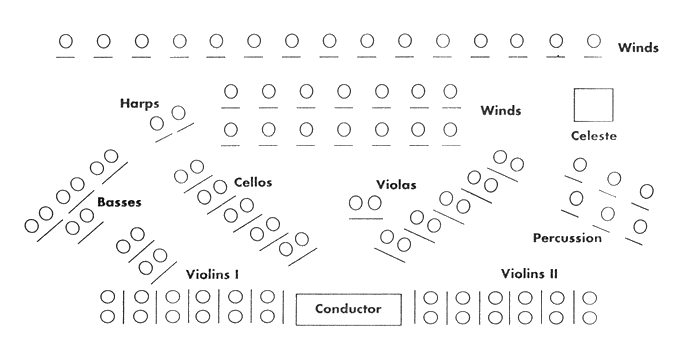 Always innovative, Stokowski changed the layout of an orchestra to suit different halls' acoustics. In the change that was most copied by other orchestras at the time and is still used widely today, Stokowski moved the 2nd violins next to the 1st violins, and placed the violas and cellos sequentially to the 2nd violinist's left. The double-basses were positioned behind and between the violas and cellos. In addition, the percussion was moved to the back of the orchestra. At this point it might be worth quoting from The Percussion Information : Problems.
|
The way players place their timpani with the high timpano on the left or right side, varies per country. And even in one country not all players use the same placement. The problem is not restricted to timpani, but all instrument setups where instruments of varying pitch have to be placed next to each other, face the problem of how to place the instruments in such a way that playing becomes easier (or at least not more difficult).
|
We illustrate this revised orchestral layout below. 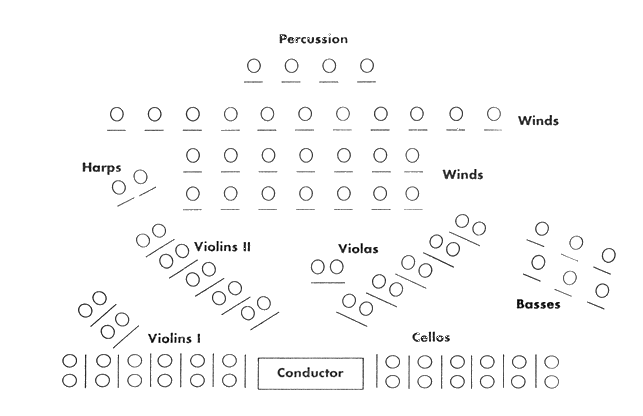 Stokowski changed his orchestra's layout in particular to overcome problems experienced during early monoaural recording. The higher strings tended to play the tune while the lower strings were restricted to the accompaniment. By physically separating the higher and lower strings, Stokowski's recordings emphasised more clearly the role within the musical score that each of different string sections played. Today, however, when recording is invariably in stereo, the Stokowski layout is thought, by some, to create a lopsided effect drawing the listener's attention to the left where the high strings are sitting so spoiling the overall balance. There has been some interest in returning to the earlier pre-Stokowski layout. For this reason. it should not be assumed that today there is only one standard orchestral layout. Stokowski interest in optimal orchestral layouts in the recording studio led to some remarkable results. Robin Maconie in Gossip: The Fantastical Fictions of Baron Stockhausen (1999) writes: "Despite claims to the contrary, avant-garde music did not erupt spontaneously in 1950. The generation of Boulez, Berio, and Stockhausen was born in a decade of rapid and significant technological innovation. Public radio started up in 1922, electrical recording came on stream in 1925, and sound film in 1927. Already by 1931, when Stockhausen was three years old, conductor Leopold Stokowski and the Philadelphia Orchestra were assisting RCA and Bell Labs in experimental hi-fi stereo broadcasts, and with the arrival of optical sound in 1932 the same team began movie-related experiments in stereo and surround-sound recording. In England at this time Alan Blumlein working for His Master's Voice was single-handedly developing microphone and disc-cutting technology for two-channel 'binaural' sound, some 25 years before stereo was launched commercially in 1956. In the mid-1930s a chance meeting between Stokowski and Walt Disney in a Beverly Hills restaurant led to the commercial development of Fantasound surround-sound technology for the movie Fantasia which eventually premiered with surround-sound in 1941, an incredibly short ten years after the first stereo experiments, and a full fifty years before Dolby Pro-Logic came on the home theatre market." "These Stokowski sessions throughout the thirties involved experiments in new orchestra layout for optimum balance in front of a microphone, techniques of multiple orchestras, multi-speaker sound systems, and systems of recording and reproducing sounds that appear to rotate around the heads of an audience. The main stumbling-block to reproducing sounds in rotation is preserving phase information which varies with spatial movement according to frequency. There is a kind of Doppler effect that on a sliding scale from low to high stretches or compresses the individual frequencies of a musical sound from a moving source. To reproduce the sound of a moving trumpet for example one has to find a way of reproducing a pattern of frequency alteration that is different for each individual harmonic. A seemingly impossible task, but the team who created Fantasound claimed to have achieved it, perhaps by rotating the microphone and not the player. Now that the remastered original sound-track is freely available on double CD (DSTCD-452 D) it is open to the public to hear and evaluate the surround-sound effect for themselves using an appropriate decoder. The music really does fly. So when Stockhausen in 1971 tells his Cambridge (England) audience an amusing story about asking whether the Cologne chapter of the musicians' union in 1955 would allow players to be suspended in chairs from the auditorium ceiling and rotated over the audience's heads, what the anecdote is really saying is that the audio technicians of North West German Radio had heard about the rotational movement of instrumental sounds in space actually happening in the movie Fantasia but that they couldn't tell him how it was done." "Radical inventions and discoveries in the field of audio have ways of impacting on musical consciousness even though the relevant technologies remain a mystery to the composers involved. Bartók's Music for Strings, Percussion and Celesta of 1936 and Sonata for Two Pianos and Percussion of 1937, as well as Bohuslav Martinu's Concerto for Double String Orchestra, Piano and Timpani of 1938 form a cluster of compositions sharing the distinction of being laid out in triptych formation, with central percussion flanked by carefully balanced forces (string orchestras or pianos) to left and right. The deliberately symmetrical layout conforms in a very obvious fashion to the practical requirements of the RCA-Bell three-channel stereo system of 1932. Stokowski does not seem to have been involved in performances of any of these works at this time. In fact both orchestral works were commissioned by the conductor Paul Sacher for his Basel Chamber Orchestra, giving rise to the intriguing question of whether Sacher might have had plans to make a concert film in stereo, perhaps as a counter to Disney's Fantasia, the idea of which was not warmly received in the best musical circles." When the Royal Festival Hall in London was being designed a lot of time was spent finding the orchestral layout best suited to the players and the audience. We quote below from The Acoustics of the Royal Festival Hall "The acoustics team from BRS carried out detailed studies of platform design and orchestral layout, in discussion with various musicians including Malcolm Sargent. It was decided that the platform should be as compact as possible, to avoid time delays between the sounds of different instruments reaching the audience, and thus aid definition. Special music stands were designed, which moved on wheels in grooves along the fronts of the tiers, rather than taking up floor space." "In keeping with the hill and lake' scheme, the original height of the platform was only 9 inches above the level of the front stalls, with the players arranged on tiers on the platform. After a few years the platform was raised to its present height, largely because soloists did not like performing on such a low stage. It was also realised that a higher platform would assist the projection of sound to the seats under the balcony, by reducing the absorption of direct sound by the audience in the stalls." "Wooden reflecting surfaces were placed around and behind the platform to assist the players in hearing each other, thereby contributing to the balance and blend of the orchestra. These surfaces also produced short reflected sound paths to the audience, to increase definition of the sound heard. The little lake' required by Bagenal, to reflect sound from the orchestra to the audience, is provided by an area of green slate embedded in the auditorium floor between the stalls and the stage." "In examining different orchestral layouts, the BRS team considered that placing all the strings on the left, enabling as much string tone as possible to be projected into the hall, would be a successful arrangement." The public's response was, initially, enthusiastic. "When the hall opened it was widely praised by audiences, critics, conductors and performers for its clarity, although there was some disquiet over its lack of warmth'. The violinists Jascha Heifetz and Yehudi Menuhin thought it had the best acoustics of any hall they had played in; Joan Hammond the singer found the acoustics excellent'; and the pianist Denis Matthews enjoyed both playing and listening in the hall." "Among conductors Leopold Stokowski said it was the finest hall in the world; Malcolm Sargent thought the acoustics were excellent; Adrian Boult liked it very much indeed'; and Josef Krips said it was the most perfect hall he knew. Other conductors, however, were more critical. For example, Otto Klemperer cancelled a performance of Elgar's Enigma Variations as he felt the acoustics of the hall were not suited to the sonorities of Elgar's masterpiece.'" "The hall's extreme clarity allowed even minor errors by players to be heard easily. Bill Allen reported that when he later asked Adrian Boult what he thought of the hall he replied that Malcolm loves it because he is a disciplinarian', whereas he himself preferred York Minster where it doesn't matter if a player is a bar late'!" "On 9 June 1951, Leopold Stokowski conducted the BBC Symphony Orchestra in Stravinsky's Rite of Spring with the orchestra arranged as suggested by BRS, with all the strings to one side. The music critics present were unanimous in their praise for the sound, commenting on the ideal balance between blend and definition', the richness of the string tone', and the clarity and fullness of tone' of the strings." "Over the years, criticism by the public and musicians about the lack of warmth, increased. In the early 1960s Peter Parkin invented the system of assisted resonance. Inspiration for the assisted resonance system came from his work in the 1950s on the speech reinforcement system in St Paul's Cathedral. The AR system was tested in the hall in 1964 and installed in 1965, in time for the hall's reopening following major refurbishment. With the system fully operational conductors, performers, critics and audiences agreed that the problem of lack of warmth had been overcome, and that the hall had become one of the best in the world. The system was in use for 30 years before being switched off permanently in the late 1990s." Contemporary composers have changed the layout of orchestras to clarify the structure of their works. The Sheffield-born composer Bernard Rands, interviewed on a work commissioned by Carnegie Hall in honor of its centennial and given its premiere there under Riccardo Muti's baton on March 18, 1991, comments on the enormous potential in spacing them, reseating or regrouping them "if intelligently handled." An example of these 'special' layouts is that chosen by Andrzej Panufnik for his symphony entitled Sinfonia Rustica and written in 1948. The composer decided to emulate symmetrical paper-cuts. The orchestral layout is symmetrical with flute, two oboes, two bassoons, two horns and trumpet in the middle of the concert platform, flanked by two string orchestras engaged in stereophonic dialogue. Again with his Sinfonia di Sfere (Symphony no 5) written in 1975, Panufnik utilizes a spherical concept that even affected the composers instrumentation. Drums became the dominant force in the orchestration. Three percussionists, each with four drums, are placed around the outside of the platform, arranged so that the sound constantly orbits the orchestra, clockwise or anti-clockwise. Four brass soloists with their circular bells stand as soloists at the centre front of the stage. Orchestral layout is also something that concerns those keen to give 'historically informed' performances. Jay Nordlinger, reviewing a concert given in the Carnegie Hall February 28, 2001, writes: "On the stage the following night was a much different orchestra, the Orchestra of St. Lukes, under Roger Norrington, its former chief conductor. Norrington is a leader of the original instruments movement, which is also devoted to original performance practices. He is usually a stirring musician, and his program at Carnegie was an appetizing one: a Mahler arrangement of various movements from Bachs Orchestral Suites; a great and beloved Bach cantata (sung by Emma Kirkby); and the Mahler Fourth (with Kirkby as soloist)." "Before beginning, Norrington made a little speech to the audience, explaining the links between the pieces to be performed, and offering a little apology, or defense: he is now interested, not only in original instruments and original performance practices, but in original size, and original everything else. He and the orchestra would attempt to perform all of these works just as they were done at the time of their debuts. Such things as the layoutthe physical layoutof the orchestra would be the same. Most significantly, the strings would use no vibrato (called the V word by Norrington). The conductor regretted that we could not know for sure, how the pieces sounded at the moment they were unveiled, in such matters as dynamics. You at times have to wonder whether Norrington and his comrades consider themselves real flesh-and-blood musicians or museum curators. The museum mentality seems to have taken over much of music." Note: The descriptions above are schematic. That is, they show the general layout for modern orchestras. The exact layout will vary according to the forces required and the space available on the concert platform. References:
Seating Plans from various Philharmonia concerts during the 2001/2 season'The Sound Orchestras Make' by Sir Roger Norrington; published in Early Music, Vol. XXXII/1 February 2004 (Oxford University Press)'Cambridge Companion to the Orchestra' edited by Colin Lawson; published by Cambridge University Press 2003
|
| 2 |
Conducting
The art of conducting began when one musician in a group was given the task of leading the other members in such a way that the result showed a sense of common purpose. Entries, speed, volume, etc. were all matters that could no longer be left to the discretion of the individual participants. Someone had to decide when to play, how to play, when to get louder or softer, etc..
| The right hand is used to give the beat: |
| The most basic role of the conductor is to give a beat - the patterns used are named for the time signatures for which they are normally required. Conductors will usually beat with their right hand (whatever hand they normally used for any other activity). When starting a pattern, the hand should be held high enough to be visible to all the performers and the movement should be animated with a little bounce of the hand at the start of each beat.
References:
|
| The left hand is reserved for other useful gestures conductors may wish to make: |
| cuing | used to help a soloist or soli section in an ensemble make his, her or their entry. A preliminary gesture (raising an index finger) alerts the performer(s) of an impending entry and a down beat with the left hand index finger marks the entry itself |
| crescendo | with the palm facing down, slowly raise a lowered hand to indicate by how much and at what rate the group should be getting louder |
| diminuendo | with the palm facing down, slowly lower a raised hand to indicate by how much and at what rate the group should be getting softer |
| preparation | to start a group, give an upbeat (that is, the beat before they start playing), then conduct the pattern appropriate to the time signature or beat pattern. The preparatory beat should be at the same tempo as the first bar |
| hold | to observe a fermata (hold) or a longer final note at the end of the piece, the hand, held at mid-level and with the palm facing up, is moved slowly to the conductor's right with the group holding the note for as long as the hand moves |
| cut-off | the conductor usually uses both hands each following opposing sides of a vertical circle so that when the hands meet the players stop |
|
|
 :: next lesson
:: next lesson
| |
 :: next lesson
:: next lesson